-
Use Cases
-
Resources
-
Pricing
Conquests and Expansion
Arab conquest of Persia
651 BCE
% complete
The Arab conquest of Persia, also known as the Muslim conquest of Iran, refers to the invasion and subjugation of the Persian Empire by the Muslims under the Rashidun and Umayyad caliphs. The conquest took place between 633 and 651 BCE, and resulted in the conversion of Persia to Islam and the end of the Sassanian Empire.
Image source: Muslim conquest of Persia

Philip II of Macedon conquers Persia
338 BCE
% complete
Philip II of Macedon, the father of Alexander the Great, leads a campaign against the Persian Empire. In 338 BCE, Philip's forces defeat the Persians at the Battle of Chaeronea, securing Macedonian control over Persia.
Decline and Fall
Fall of the Sassanian Empire to the Islamic Caliphate
651 BCE
% complete
The Fall of the Sassanian Empire to the Islamic Caliphate marks the end of the Sassanian Empire and the beginning of the Islamic caliphate in Persia. In 651 BCE, the last Sassanian ruler, Yazdegerd III, was defeated by the forces of the Islamic Caliphate led by General Khalid ibn al-Walid. This event resulted in the conversion of much of Persia to Islam and the introduction of Arabic as the dominant language. It also marked a significant shift in political and cultural power in the region, as the Islamic Caliphate established its authority over the former Sassanian territories.
End of the Persian Empire
330 BCE
% complete
The End of the Persian Empire marks the defeat of the Persian Empire by Alexander the Great in 330 BCE. After years of conquest, Alexander and his army successfully invaded the Persian Empire and captured its capital, Persepolis. This event led to the downfall of the Persian Empire and the establishment of the Hellenistic period in the region.
Battles and Conflicts
Battle of Qadisiyyah
636 BCE
% complete
The Battle of Qadisiyyah was fought in 636 CE between the Arab Muslims led by the Rashidun Caliphate and the Sassanid Empire. It was a decisive battle that resulted in the Islamic conquest of Persia. The battle took place near the city of Qadisiyyah in present-day Iraq. The Arab Muslims, under the command of Saad ibn Abi Waqqas, utilized innovative tactics and superior strategy to defeat the Sassanid forces, which were led by Rustam, the Persian general. The battle lasted for several days, with intense fighting and heavy casualties on both sides. Ultimately, the Arab Muslims emerged victorious, marking a significant turning point in the history of the Persian Empire.
Image source: Battle of al-Qadisiyyah

Battle of Nineveh
627 BCE
% complete
The Battle of Nineveh was fought between the Byzantine Empire and the Sassanian Empire in 627 BCE. The Byzantine Emperor Heraclius led his army to victory against the Sassanian forces, capturing the capital city of Nineveh and dealing a significant blow to the Sassanian Empire. This battle marked the beginning of the end for the Sassanian Empire and helped pave the way for the Muslim conquests of the region.
Battle of Marathon
490 BCE
% complete
The Battle of Marathon was a battle in the Greco-Persian Wars that took place in 490 BCE. It was fought between the citizens of Athens and an invading Persian army. The Athenians, led by the general Miltiades, successfully repelled the Persians and secured a crucial victory. This battle is significant because it marked the first Persian defeat in their attempts to expand their empire into Greece, and it also boosted the morale of the Athenians, setting the stage for their later victories in the war.
Image source: Battle of Marathon

Invasion of Greece by Xerxes I
480 BCE - 479 BCE
% complete
The Invasion of Greece by Xerxes I was a military campaign launched by the Persian Empire under the rule of King Xerxes I. It took place from 480 BCE to 479 BCE and was a direct response to the Persian defeat at the Battle of Marathon in 490 BCE. Xerxes I sought to assert Persian dominance over Greece and expand the Persian Empire further west. The invasion consisted of a massive Persian army and fleet, estimated to be over 100,000 soldiers and 800 warships. The Persians initially faced little resistance as they advanced through northern Greece, capturing and sacking several cities. However, they met fierce resistance at the Battle of Thermopylae and were eventually defeated by a coordinated Greek alliance led by Sparta at the Battle of Plataea. The invasion marked a pivotal moment in the Persian Empire's expansion efforts and showcased the resilience and determination of the Greek city-states to defend their independence.
Image source: Second Persian invasion of Greece
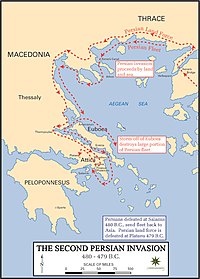
Peloponnesian War between Athens and Sparta
431 BCE - 404 BCE
% complete
The Peloponnesian War was a conflict between the city-states of Athens and Sparta in ancient Greece. The war lasted from 431 BCE to 404 BCE and was fought over control and influence in the Greek world. It was a major event in Greek history, leading to the decline of Athens as a dominant power and the rise of Sparta as the leading city-state. The war was marked by a series of battles, sieges, and alliances, and it had a profound impact on the political, social, and cultural landscape of Greece.
Revolt of the Satraps
366 BCE
% complete
The Revolt of the Satraps was a rebellion against the central authority of the Persian Empire by several regional governors known as satraps. It took place in 366 BCE and was led by satrap Artabazus of Phrygia. The revolt lasted for several years and resulted in a significant loss of control for the Persian Empire.
Image source: Great Satraps' Revolt
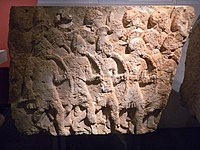
Alexander the Great defeats Darius III at the Battle of Gaugamela
331 BCE
% complete
The Battle of Gaugamela took place in 331 BCE between Alexander the Great of Macedonia and Darius III of Persia. It was a decisive victory for Alexander, resulting in the fall of the Persian Empire.
Image source: Battle of Gaugamela
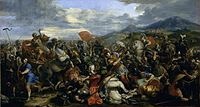
Rulers and Dynasties
Rise of the Achaemenid Dynasty
559 BCE
% complete
The Achaemenid dynasty was founded by Cyrus the Great in 559 BCE. He overthrew the Median Empire and established the Persian Empire, which would go on to become the largest empire of its time.
Cyrus the Great establishes the Persian Empire
550 BCE
% complete
Darius I becomes the ruler of Persia
522 BCE
% complete
Darius I becomes the ruler of Persia in 522 BCE. He ascends to the throne after the death of his predecessor Cambyses II. Darius I, also known as Darius the Great, was a Persian king of the Achaemenid Empire. He ruled from 522 BCE until his death in 486 BCE. Darius implemented administrative and economic reforms, expanded the empire, and established an efficient system of governance. He is also known for his extensive building projects, including the construction of the royal palace complex at Persepolis.
Image source: Darius the Great

Xerxes I becomes the ruler of Persia
486 BCE
% complete
Xerxes I becomes the ruler of Persia in 486 BCE. He succeeded his father, Darius I, and ruled until his death in 465 BCE. Xerxes I is known for his ambitious military campaigns, including the famous invasion of Greece in 480 BCE. He also continued many of the administrative and cultural policies of his father, solidifying the power and influence of the Persian Empire.
Image source: Xerxes I
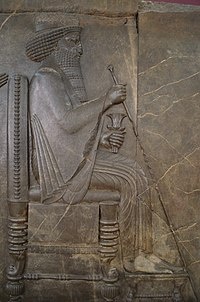
Artaxerxes I becomes the ruler of Persia
465 BCE
% complete
Artaxerxes I becomes the ruler of Persia (465 BCE)
Seleucid Empire established after Alexander's death
312 BCE
% complete
The Seleucid Empire was established after the death of Alexander the Great in 312 BCE. It was founded by one of Alexander's generals, Seleucus I Nicator, who became the ruler of the eastern portion of the empire. The empire lasted for more than two centuries and covered a vast territory, including parts of modern-day Iran, Iraq, Syria, Lebanon, and Turkey. The Seleucids adopted Greek culture and language, but also incorporated elements of Persian and Babylonian culture. They faced numerous challenges, including conflicts with neighboring kingdoms and rebellions from their own subjects. Despite these challenges, the Seleucid Empire made significant contributions to the region, including the establishment of cities, the spread of Hellenistic culture, and the promotion of trade and commerce.
Parthian Empire gains independence from the Seleucids
247 BCE
% complete
Parthian Empire gains independence from the Seleucids (247 BCE)
Image source: Seleucid–Parthian Wars

Sassanian Empire overthrows the Parthians
224 BCE
% complete
The Sassanian Empire, also known as the Neo-Persian Empire, overthrows the Parthians in 224 BCE. The Sassanian Empire was founded by Ardashir I, who led a rebellion against the Parthians and established himself as the new ruler. The Sassanian Empire went on to dominate Persia for over 400 years, until it was eventually conquered by the Islamic caliphate in the 7th century CE.
Image source: Sasanian Empire

Cultural Achievements
Construction of Persepolis begins
518 BCE
% complete
Construction of Persepolis begins (518 BCE)
Construction of the Royal Road
500 BCE
% complete
Construction of the Royal Road was a major infrastructure project undertaken by the Persian Empire during the reign of Darius the Great. The road stretched for over 1,500 miles from the city of Susa to the coast of the Aegean Sea. It was built to facilitate communication and trade within the empire, allowing for faster and more efficient transportation of goods and people. The construction involved the clearing of obstacles, such as mountains and rivers, and the development of rest stops and postal stations along the route. The Royal Road played a crucial role in the expansion and governance of the Persian Empire, enabling the rapid movement of armies and royal messengers. It also facilitated cultural exchange and economic growth, as it connected the diverse regions of the empire and facilitated trade between them. Construction of the Royal Road started around 500 BCE and was completed within a few years, making it one of the most impressive engineering feats of the ancient world.
Image source: Royal Road
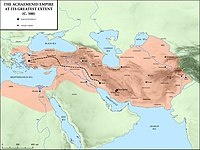
Construction of the Gate of All Nations at Persepolis
460 BCE
% complete
Construction of the Palace of Shapur I at Ctesiphon
241 BCE
% complete
Construction of the Palace of Shapur I at Ctesiphon (241 BCE).
The Palace of Shapur I at Ctesiphon was built in 241 BCE during the reign of the Sasanian king Shapur I. It served as the official residence of the Sasanian kings and the administrative center of the empire. The palace complex covered an area of over 20,000 square meters and was known for its grand architecture and luxurious decorations. The main building, known as the Taq-i Kisra or the Arch of Ctesiphon, was an architectural marvel and one of the largest single-span vaults in the world. It stood as a symbol of the power and wealth of the Persian Empire. The palace was destroyed by the Arab forces in the 7th century but its ruins still remain as a prominent historical site.
Image source: Taq Kasra

Key Facts
- The Persian Empire was founded by Cyrus the Great in 550 BC.
- Under Darius the Great, the empire reached its greatest territorial extent, spanning from Egypt to India.
- The Persian Empire was known for its administrative efficiency and cultural tolerance.
- The Greco-Persian Wars were a series of conflicts between Persia and the Greek city-states.
- The empire fell to Alexander the Great in 330 BC, marking the end of the Persian Empire.
Source
This Persian Empire timeline was generated with the help of AI using information found on the internet.
We strive to make these timelines as accurate as possible, but occasionally inaccurates slip in. If you notice anything amiss, let us know at [email protected] and we'll correct it for future visitors.
Create a timeline like this one for free
Preceden lets you create stunning timelines using AI or manually.
Customize your timeline with one of our low-cost paid plans
Export your timeline, add your own events, edit or remove AI-generated events, and much more
Free
$
0
free forever
No credit card required.
Basic
$
10
/month
billed annually
Cancel anytime.
Pro
$
16
/month
billed annually
Cancel anytime.
Common Questions
Can I cancel anytime?
Yes. You can cancel your subscription from your account page at anytime which will ensure you are not charged again. If you cancel you can still access your subscription for the full time period you paid for.
Will you send an annual renewal reminder?
Yes, we will email you a reminder prior to the annual renewal and will also email you a receipt.
Do you offer refunds?
Yes. You can email us within 15 days of any payment and we will issue you a full refund.
What if I have more questions?
Check out our pricing docs or send us an email anytime: [email protected].

